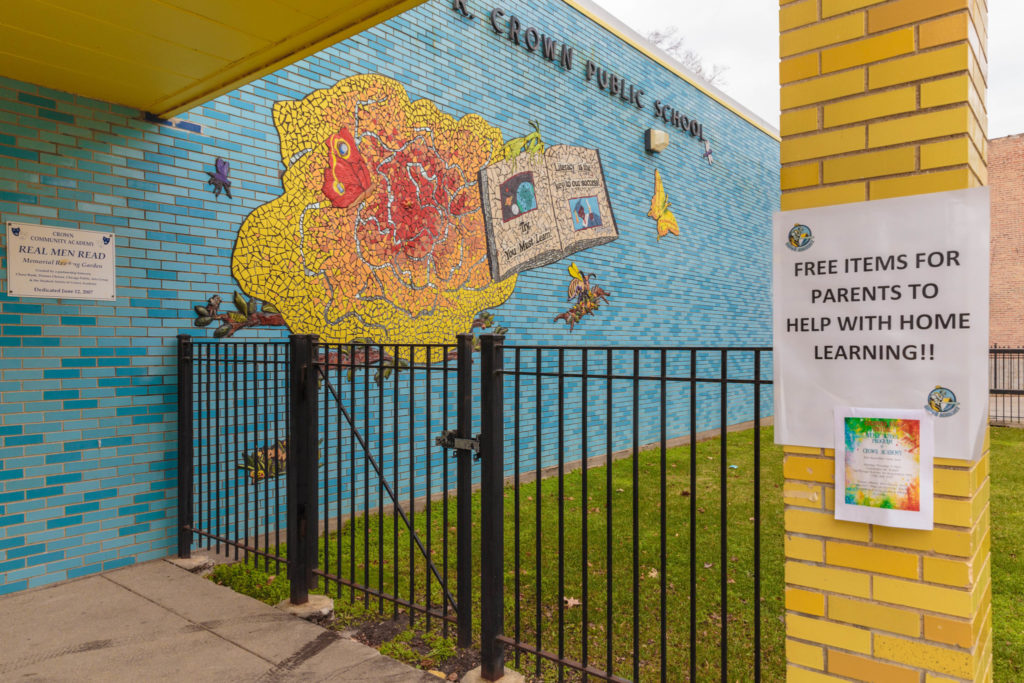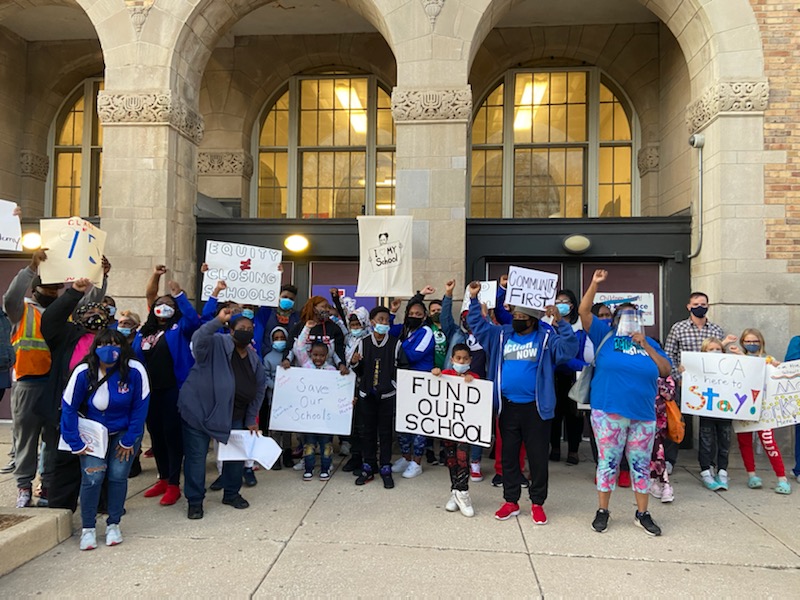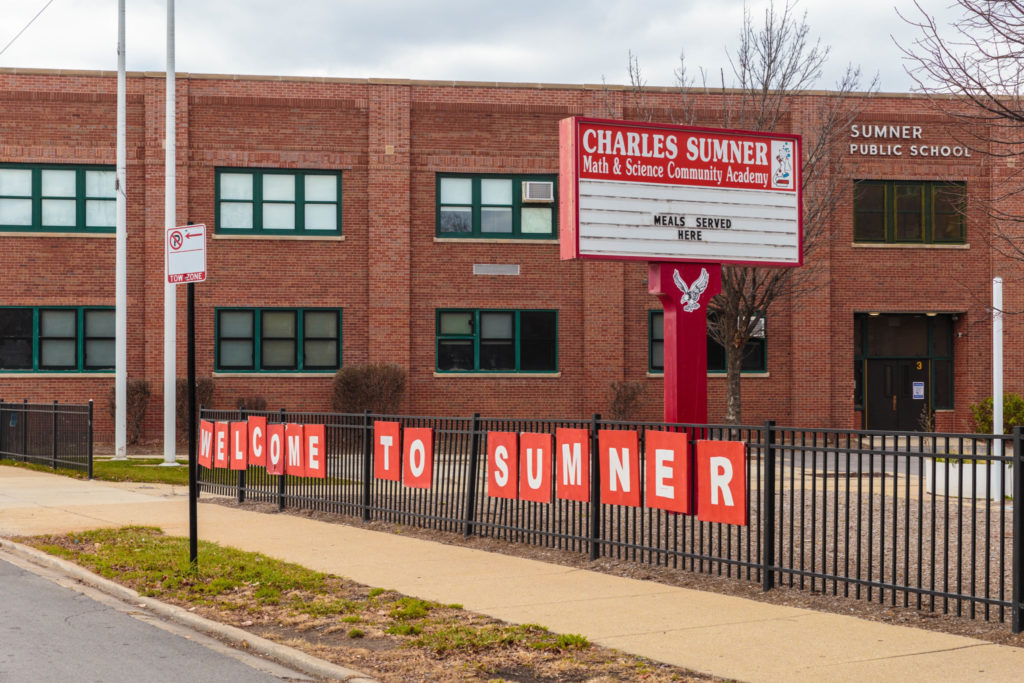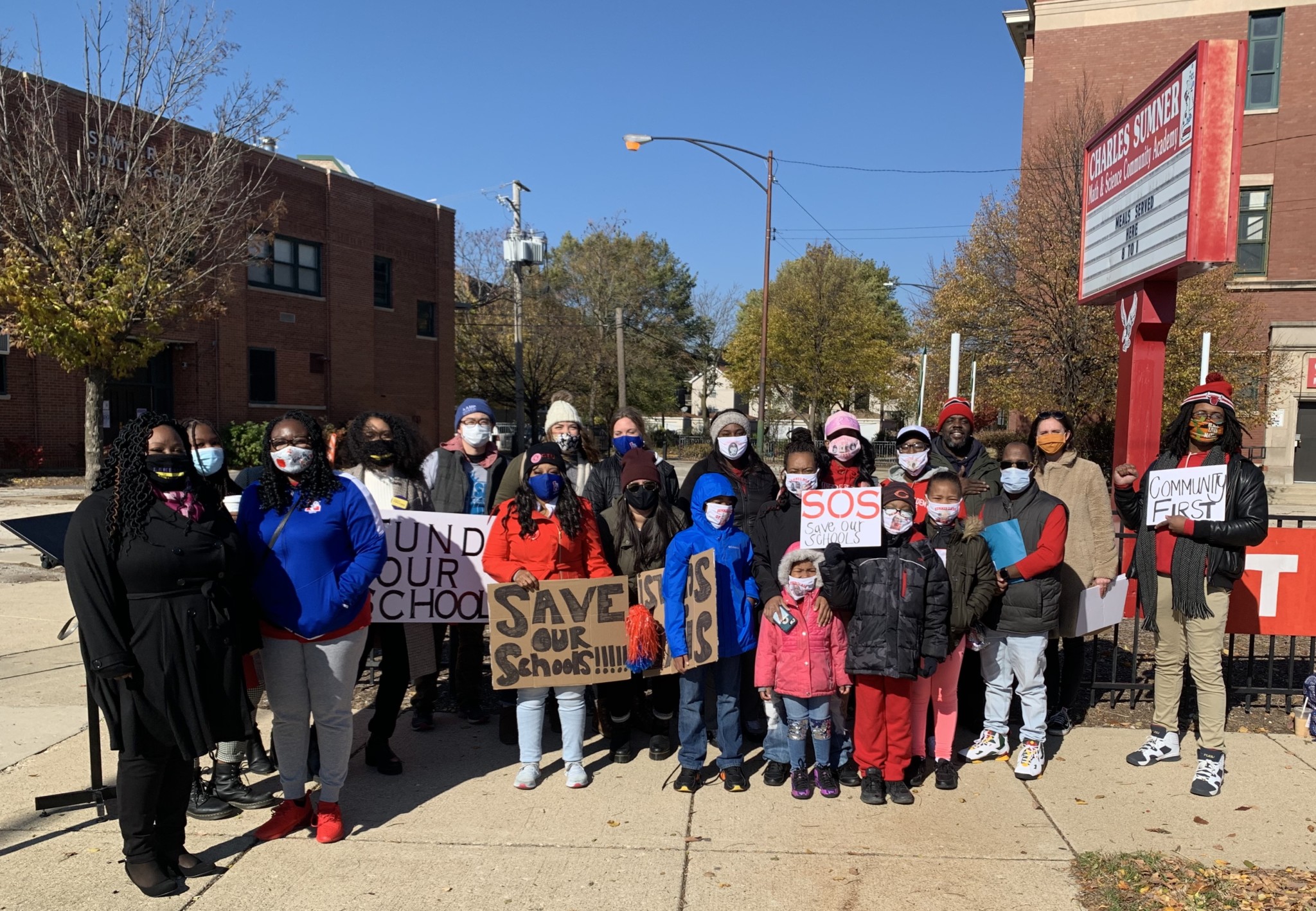Tireless organizing over the past month has prevented the closure of three public elementary schools on the West Side. The North Lawndale Community Coordinating Council (NLCCC) proposal would have consolidated three neighborhood schools—Lawndale Community Academy, Sumner Math and Science Community Academy, and Crown Community Academy of Fine Arts—into a new STEAM (Science, Technology, Engineering, Arts and Math) Partnership Academy.
But community residents, many of whom felt the plan did not address the true issues faced by the neighborhood, and plagued by memories of past school closings, formed a group to organize against it. Now, the North Lawndale Parent and Community Coalition (NLPCC) is creating an entirely parent-led proposal which calls for the $65 million dollars proposed for the new school to instead be invested into the existing schools in ways that genuinely address the root causes of under-enrollment.
The idea for a STEAM school originated from the NLCCC’s 2018 Quality-of-Life Plan, which sought to address issues like housing, economic development, transportation, and public safety. They submitted their proposal to Chicago Public Schools (CPS) on November 2. It would have closed and consolidated the three schools into Sumner’s campus for a new pre-K-8 STEAM school, which would allegedly offer hands-on learning experiences in science, technology, engineering, and mathematics in a new state of the arts facility.
These three neighborhood schools are not failing schools: Crown is rated Level 2+, Lawndale is rated Level 2, and Sumner is rated Level 1, based on CPS’s School Quality Rating Policy which goes from 1+ to 3, where 1+ is the highest rating. Instead, the NLCCC cited under-enrollment in the three schools as the motivation behind the proposal. According to CPS data, during the 2019-2020 school year Lawndale was at 24 percent capacity, Sumner was at 20 percent capacity, and Crown was at 31 percent capacity.

CPS calculates space utilization by comparing a school’s actual enrollment to its “ideal” enrollment capacity. But this method of calculating a school’s “efficiency” has been criticized.
Jianan Shi, the executive director of Raise Your Hand for Illinois Public Education, said the formula for school utilization is “a rigid formula; it doesn’t include the different factors that are in a school, looking at different needs of different programs, elementary versus high school, the different settings, how it includes and counts spaces. Ultimately it’s based off certain numbers that don’t quite make sense for every student and every kind of program.”
“I think that conversations about building utilization are odd, because building utilization is not an educational quality question—it’s a budget and management question,” said Eve Ewing, a UofC sociologist, poet, and author of Ghosts in the Schoolyard: Racism and School Closings on Chicago’s South Side. “When we start basing policy decisions on how many children are in a building, we’re asking families and students to accept choices made based not on what’s best for teaching and learning, but on what’s best for the bottom line.”
Community Concerns
Parents and community residents were skeptical of the promise that the new STEAM school would guarantee spots for each of the 620 children in the three neighborhood schools. The proposal stated that the new school would have 700 spots. But it would have ultimately been up to CPS to decide who could attend the school, which could include making it a selective enrollment school or requiring tests for admission, advocates said.
Christel Williams-Hayes, the recording secretary of the Chicago Teachers Union (CTU), remembers her experience as an organizer on the West Side when they closed four schools in Englewood in 2019 to open a new Englewood STEM high school. CPS officials said they would guarantee a spot for each of the kids in the closed schools, she said, “and they lied.”
One purpose of the proposal and the Quality of Life plan was to stop the cycle of parents sending their children to schools outside of North Lawndale. According to the plan, in 2018, thirty-one percent of K-8 and sixty-nine percent of high school students living in North Lawndale were enrolled in a school outside of the neighborhood.
“They think that this new STEAM school will bring people back to the area, because obviously you would have to live in the attendance area to attend the school,” said Shavon Coleman, a community resident and pre-K teacher’s assistant at Lawndale Community Academy, and an alumna of the school herself. “If your enrollment is going to be 650 to 700 children, and you may have 200 kids in each of these three schools, that only leaves 100 more slots I’m supposing. But [if] anyone from the neighborhood can go there, how are you saying in your proposal that you guarantee our children a slot?”
“We all know that this new STEM school is being created for a new group of people that this whole regentrification process is preparing for,” Williams-Hayes said. “We already know that kids are going to have to test to get in here, and they’re not going to be accepted.”
Many community residents also felt like they had been kept in the dark about the proposal. The NLCCC stated that they had held more than fifty public meetings with about 300 residents since 2018, but many parents and teachers said that they had not heard about the proposal before the beginning of the school year. “I don’t know who they spoke with but I know my parents didn’t really know anything about it,” said Tasha Dudley, a fourth and fifth grade math and science teacher at Crown. “I would have thought that if they were talking to all these people they would have talked at least to a few of the Crown parents.”
Coleman, who is in her Local School Council (LSC), only found out about the proposal in August at a meeting held by the NLCCC. “So, if the LSC of the school is just finding out, no one knew at the time,” she said. After organizing efforts began, she realized most people in the neighborhood hadn’t heard about it.
There was also pushback from the students. At an NLCCC press conference in October, Latajah Wilson, a fifth grader at Sumner, spoke out against the new proposal. “It’s sad how y’all just wanna close our school down just ‘cause we don’t got enough stuff in there,” she said through tears. “I only went to this school three years, and I have learned so much about these teachers and they care so much about us.”
Though initially undecided about how she felt about the proposal, Dudley was swayed when she conducted a poll in her fourth and fifth grade classrooms at Crown and found that 85 percent of her students wanted it to remain open. 40 percent said they liked it the way it was, and 45 percent said they wanted some slight improvements, “things that can be fixed, it was nothing major that the STEAM school could really offer them,” said Dudley.
“A lot of what they talked about was basically the comfort levels, the normalcy, their friends…it hit me hard because they were like ‘are you going to be there?’”
The new STEAM school would not guarantee spots for each of the teachers and staff members in the three existing schools. “What’s unfair is that we would have to reapply for our positions,” said Coleman.
Relationships, Dudley said, are the most important aspect of school for her students. “I think just for the demographic that I teach, relationships are almost everything,” she said. “If their relationship is not there, if you don’t feel cared for, that’s when you get the spiraling out of control.”
Dr. Aisha Wade-Bey, a fifth and sixth grade language arts teacher at Lawndale, also discussed the proposal with her students. “Oh, the children, they spoke up, they were very disenfranchised about closing their schools because they said they feel connected to their teachers, they feel connected to their friends, they feel connected to Lawndale.”
Parents, teachers, and community members were also concerned that the proposal did not address the root causes that led to under enrollment in the three schools in the first place. “No one’s talking about the disinvestment in the schools or in the North Lawndale community itself. No one’s talking about the unaffordable housing in the area, no one’s talking about the violence,” Coleman said.
A History of Disinvestment
For many, the threat of school closings brought back painful memories of 2013 when Mayor Rahm Emanuel’s administration shuttered fifty CPS schools, predominantly on the South and West sides; eighty-eight percent of the students in the schools that were closed were Black. And these three schools are predominantly Black and low-income: according to CPS data, Lawndale is 97.6 percent African American and 97.6 percent low-income, Crown is 90.2 percent African American and 83.3 percent low-income, and Sumner is 97.5 percent African American and 92.5 percent low-income.

Two schools in North Lawndale were shuttered: Matthew A Henson and Nathaniel Pope Elementary School. Henson was sold to Single Room Housing Assistance Corporation (SRHAC) in 2018 to build affordable housing, though the building is currently empty; SRHAC said that the building is still in progress and has not been opened yet. Pope was slated to be used by the Chicago Housing Authority.
“I can remember… parents crying and saying ‘don’t close our school, we’ve been here forever,’” Williams-Hayes said. “I saw the change that the closing schools did, I saw children separated—one having to go to one school because they couldn’t get accepted to the other school, it was just really crazy.”
For some teachers, having to fight against school closures is a recurring nightmare. In 2013, Wade-Bey successfully fought alongside other community members to keep Bronzeville school Thomas A. Hendricks open. In 2015, she was part of the thirty-four-day hunger strike to keep open Walter H. Dyett High School for the Arts in Washington Park, which forced the district to listen to their demands to reopen the school and increase funding and programs. “And so now here we are in 2020, I’m at Lawndale, and they were talking about Lawndale closing.”
“We see so many vacant lots and vacant buildings over there it’s ridiculous,” Coleman added. “So are you telling me that you want to close these schools and have them stay vacant as well? Because all of those schools that closed in 2013, a lot of them are sitting boarded up when they were once utilized for something positive.” According to the Quality of Life plan, North Lawndale has more than sixty acres of vacant commercially zoned land. And according to NLCCC’s 2016 Existing Conditions Report, the neighborhood has 274 acres of vacant land in total—nearly eighteen percent of North Lawndale’s land.
Most recently, the Board of Education closed Frazier Charter School due to “poor performance”. Coleman told the story of the parent of a third grade student who had just moved to Lawndale from Frazier. “I ache for her, because how many more schools will she have to move her son to before they get it right?”
Shi spoke about the distrust and the broken promises continually made by CPS. “In 2013, there were students that they could not find still, that they could not track,” he said. “There were many students that they couldn’t actually make sure that they had followed through on and were actually at another school.”
“The biggest thing is the huge destabilizing force,” he added. “Schools are not just places where students spend their time to learn academic courses. They are part of a community fabric.”
A report by the UofC Consortium on School Research found that after school closings in 2013, it was hard for staff and students from the closed schools to build new relationships because they were mourning the loss of their school communities. Students often felt unwelcomed and marginalized in their new schools, where there was an increase in fights and bullying after their arrivals. And on average, closing schools did not improve student outcomes—in fact, students affected by school closures experienced negative effects on test scores.
Aldermanic Inaction
Community members were upset that 24th Ward Alderman Michael Scott refused to take a side on the issue. “He said he was being neutral. And the question is, how can you be neutral when you have three schools that are up for closure?” Bey said. Coleman said the alderman made a statement that he can’t visit every school and can’t be at every meeting. “Well sir,” she said, “I’m here to tell you that maybe you cannot be at every meeting, but by now, because you have been alderman for a couple years, you could have very well visited every school in your ward. You’re not going to sit here and lie in my face.”
She added that parents have repeatedly invited Scott to events at the school, none of which he has shown up to. “So there’s not a lot of trust in the alderman at all,” she said.
Scott did not respond to a request for comment from the Weekly.

Ewing pointed out that because the leadership at the Board of Education and CPS is appointed, unlike every other municipality in Illinois where people get to elect those positions, community members turn to aldermen in the hopes that the pressure of re-election might make them more supportive of their concerns. “It’s really discouraging and confusing for parents and community members,” she added. “Across the city, we need new models of truly participatory governance that allow Chicagoans to truly inform the systems that affect their lives, rather than just being reactive to decisions made without them at the table.”
At a meeting held by the NLCCC and CPS on November 2, Scott, who is the Chairman of the City Council’s Committee on Education and Child Development, said that the three neighborhood schools may close anyways. “We can still lose these schools,” he said. “Because down the road, when our numbers continue to dwindle, that will happen.”
Shi balked at the alderman’s prediction. “There are ways we can build strong community schools,” he said. “I think it’s a false choice that they’re saying those schools are inevitably going to get closed down. Yeah, sure, if they keep starving a school, sure. If you don’t fully resource a school in a community. But again, aldermen, CPS, the community have options to improve it.”
Dixon Romeo, an organizer with United Working Families and the NLPCC, said he understood why the promise of a new school may seem attractive to some. “Because [disinvestment has] been going on for so long, people are used to drinking so much sand. It’s like you’re in a desert. If you’ve been drinking sand for years, dirty water looks really really good. Salt water looks really really good,” he said.
“And I think educating and giving money for Black children, there isn’t a price tag. That’s not an investment,” he added. “What we’re talking about is a debt. The city, state, country owes these Black students so much because of what has historically been taken from them. I think it’s unfortunate that the city and CPS oftentimes feel like they have to take with one hand and give with the other. In order for us to get good stuff, we have to lose things that are essential. Schools are essential.”
Organizing Ahead
After the press conference at Sumner, organizers did extensive outreach to “the real community, the stakeholders, to let them know what’s going on under our noses, and they didn’t have a clue of it,” said Coleman.
The NLPCC created Facebook, Instagram, and Twitter pages, as well as a petition which now has over 1,600 signatures, and held weekly organizing meetings. They sent emails to the Board of Education, the mayor, the alderman, and members of the coalition spoke at the November Board of Education meeting. “We are here because we are the front-liners and we’re letting you know what we are hearing and what we are seeing,” said Lisa Torres, a special education classroom assistant (SECA) at Crown. “We went out in the community, canvassed, knocked on doors, spoke to the people in the community, spoke to businesses, passed out flyers, giving them information about what’s going on, and one after another nobody knew what we were talking about.” They knew that they were working on a tight timeframe. “They were pushing this proposal trying to get it approved by November 30,” Coleman said.
On December 1, CPS sent a letter to parents that said the NLCCC “withdrew their proposal in order to better engage with parents impacted by the proposal.”
Dudley said parents talk about how much Crown has improved since they hired a new principal. “A lot of the parents were saying, and they’ve been there before I came, that it’s definitely different, it’s better, even the school building looks better,” she said. “They talked about the upkeep of the building, they talked about students having different learning experiences and being happy about their education, even our parent engagement.”
She also described a STEM night which took place in February, right before the onset of COVID-19, with math and science games, parent participation, and a middle school science fair.
Among Lawndale’s partnerships is a mentorship program called Pitch In, an after-school program in which mentors help kids with homework and host monthly Family Dinners. This program is still occurring online.
Lawndale has also been partnered with the Egan Office for Urban Education and Community Partnerships at DePaul University for the past six years. Highlights of the partnership include JumpStart, a literacy and social emotional program for Pre-K kids, as well as a tutoring program for kindergarteners and first, fifth, sixth, and seventh graders. John Zeigler, the director of the Egan Office, also talked about their nursing program in which nursing students serve in the school and the help they offered Lawndale in building their first website.
Zeigler is excited about programs moving forward, like an upcoming virtual college tour of DePaul with students, as well as the planning of a Kwanzaa ceremony with eighth graders. He also discussed their Veterans Read program that they are currently planning to implement at Lawndale.
The NLPCC is going to continue to advocate for the three neighborhood schools. After the proposal was withdrawn, they released a statement declaring their intention to begin the process for a parent-led proposal that will call for the $65 million dollars that would have been used for the STEAM school to be invested into the existing schools. “What I heard from all of [the parents] was that if folks have money and resources to give to North Lawndale, we don’t have to wait for there to be a new building to do it. We need to be doing it right now,” said Romeo.
Dudley said her students at Crown need more social emotional support. “I just think that needs to be a priority for CPS. Because trauma has such a major major effect on people, not just kids but adults as well, and I don’t think we’re adequately dealing with that, because I think if we deal with that, then the rest will kind of work itself out.”
Bey discussed how her students at Lawndale said they wanted a language program in the school, improvements to their science lab, and better computers for remote learning.
“Tell them we have a library without a librarian,” Coleman said about Lawndale. “Why is it that nurses aren’t in our schools all the time, not just once or twice a week? These are the things that we need in order to survive.”
The NLPCC is looking for support from the over twenty-five partners for the proposed STEAM Academy, which include fiscal planning partners like BMO Financial, Cinespace, Exelon Foundation, McGowan Family Fund, People’s Gas, the Steans Family Foundation, Chicago Mercantile Exchange, and Cabot Microelectronics.
Moving forward, they will be looking to see how those partners respond to the new parent-led proposal. “Why are these nonprofits or companies only attracted to supporting Black and Brown students when it’s shiny and new?” Shi said.
Williams-Hayes echoed this concern. “You have investors that want to come into that community and invest in it,” she said, “but not be a part of what’s there.”
Madeleine Parrish grew up in New Jersey and is currently a University of Chicago political science undergraduate. She last wrote about high school student activists who organized to remove CPD from public schools.



